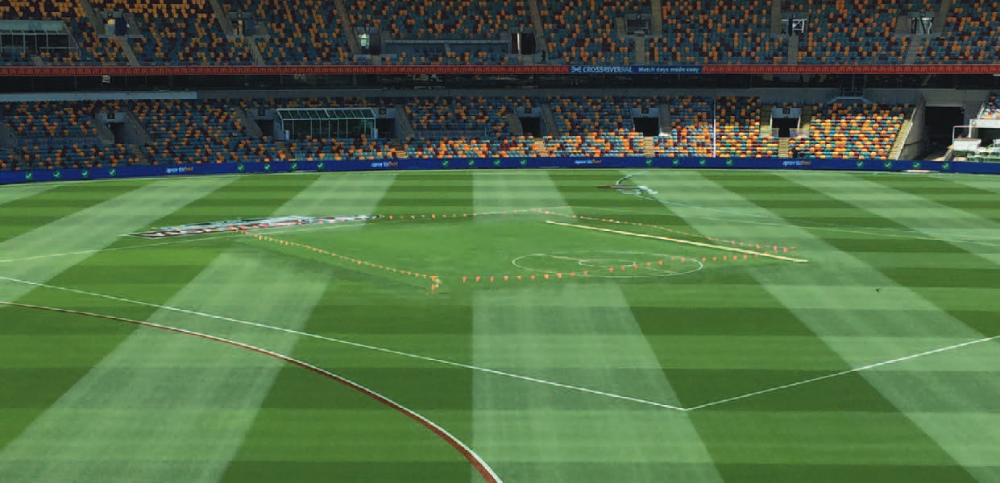An Autumn Application Approach to Spring Dead Spot
Spring Dead Spot (SDS) of couch grass is a member of the Ectotrophic Root Infecting group of fungi. The ERI group covers a number of additional diseases commonly seen on intensively managed turf such as couch grass decline and take all patch but symptom expression and host specificity allow separation to discrete diseases.
The complex has certain diagnostic features highly typical for the family which can be used for preliminary identification purposes. They can be identified by runner hyphae that travel along root structures that then peg in to the root at intervals. For Spring Dead Spot the roots of affected plants turn dark brown to black and regrowth of grass into affected patches is slow with patches potentially remaining barren and vulnerable to colonization with weeds.
This is a fungi that has visible symptom development well after an infection has occurred and it is the ‘infection window’ that must be understood for effective treatment and prevention.

Infection window and symptom expression
Late summer there is a point where soil temperature and the related root activity of warm season grasses progressively declines and the activity (read: infecting potential) of the SDS pathogen rises. The competitive edge shifts in favour of the pathogen and the crossover point is our infection window target that a treatment needs to address. There is a reasonable consensus this target is around the 20 degree celcius average soil temperature point and this is coming from quite recent work not 30 years ago. Targeting this crossover is critical but knowing in advance where this occurs and ensuring an appropriate dose of a suitable treatment is in the right place at the right time is a challenge.
The outcome of an autumn infection is clearly visible symptoms approximately 5-6 months later. Circular patches of bleached, straw coloured dead grass appear as the dormant grass resumes its growth in spring. Often when adjacent grass attempts to recolonize an affected area it remains stunted and unwell. The affected ‘spots’ cannot be retrospectively treated. It often has to be plugged, have patches fully replaced, or nursed considerably through summer looking to gain coverage – often an unsuccessful exercise.
Tools and Timings
To avoid the dreaded dead spots our late summer into autumn period needs good planning and execution of a solid prevention strategy. A number of products are registered for use against SDS. This isn’t normally the limiting factor for success – it’s usually a timing thing with a secondary issue of proper product placement. If we knew in advance the exact infection point and could predict our climate accurately then theoretically we could have a single attack strategy. But we can’t and don’t so the timing issue means this cannot be a strictly calendarized activity. We need to extend our assumed infection window to ultimately cover the critical point. In different geographies the critical crossover point will be different and year to year on any given site the prevailing environmental conditions can shift the point earlier or later. We therefore plan for multiple applications that cover a window of time.
In northern states e.g. SE QLD the autumn transition can be much longer. In such areas stepping up to a three application strategy can be appropriate. For areas like Sydney sometimes this can be appropriate as well especially if we get an Indian summer where autumn continues on and days stay warm well into May. Victoria tends to have autumns that are more predictably earlier and shorter in duration making a two application strategy quite reasonable to plan for.
For Queensland, three applications where the first is nominally around last week of February is a good assumption. This can move to first couple of weeks of March if extreme heat is continuing. From there applications are performed at 21-28 day intervals. Sydney will often have the same (or similar start point) with the same caveat on daytime and night time temperatures and same application interval. Victoria adopts same interval but will start absolutely no later and may even come forward a week if the season appears to be ending prematurely. Observation of prevailing conditions is critical.
The tools to employ usually fall to either our traditional benchmark strobilurins and triazoles or possibly some of our new SDHI options labelled for SDS. The main caveat on the tools used pertains to ultra dwarf couch greens in the Northern Rivers and Queensland areas. The growth regulating potential of the triazoles is a much debated issue, but where this can be significant is on these ultra dwarf greens when the heat has truly ended and the turf is slowing rapidly. Triazoles appear not to impact these turf at peak growth but they do seem a bit vulnerable once the season has turned. For this reason if a full rate triazole is to be employed in a 3 application strategy it should be limited to application 1, then either a mixture should be used that delivers a comparatively lesser triazole dose or a non triazole option (e.g. strobilurin only). Couch grasses grown on sportsfields that have a higher cut height and are a non-dwarf types anecdotally appear far less susceptible to this issue.
Application essentials
The disease being treated here is a root infecting pathogen. Therefore, placement of treatments in the actual rootzone is essential for success. This means high application volumes (800L + / ha) ideally delivered through 08 nozzles or better still floodjets that deliver big droplets that roll of foliage to place on the soil surface.
A post application wash in is required to get the treatment into the rootzone where the pathogen lurks. Adherence to this application regime is absolutely essential.
How Nuturf can help you
Nuturf stock all the key active ingredients and brands labelled for Spring Dead Spot. We offer the traditional triazoles and strobilurin chemistries as solo options or in combination products. We stock new generation SDHI chemistries such as Velista and also offer penetrant surfactants that can aid proper delivery of the products to the root zones needing treatment.
We can also assist with further technical advice in understanding the different attributes of the chemistries available, practical tips on the application process looking for optimization of the treatment and further advice on the biology of the pathogen to help you better understand this unique challenge.











